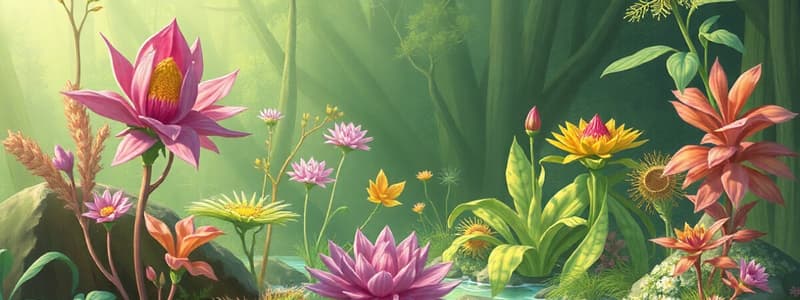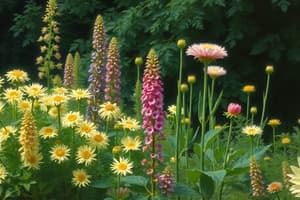Podcast
Questions and Answers
What is the primary adaptation that allows plants to survive in dry environments?
What is the primary adaptation that allows plants to survive in dry environments?
- Reduced photosynthesis activity
- Increased tolerance to cold temperatures
- Resistance to desiccation (correct)
- Enhanced nutrient uptake
In the lifecycle of most plants, which stage is classified as haplodiplontic?
In the lifecycle of most plants, which stage is classified as haplodiplontic?
- Sporophyte
- Seedling
- Gametophyte (correct)
- Gamete
What characterizes the diplontic life cycle stage observed in humans?
What characterizes the diplontic life cycle stage observed in humans?
- Total absence of diploid stage
- Presence of a multicellular gametophyte
- Brief haploid phase during reproduction (correct)
- Dominantly haploid stage
Which characteristic defines most plants in the plant kingdom?
Which characteristic defines most plants in the plant kingdom?
Which of the following adaptations is NOT found in terrestrial plants?
Which of the following adaptations is NOT found in terrestrial plants?
What is the significance of desiccation for land plants?
What is the significance of desiccation for land plants?
What do sporangia in seedless plants do?
What do sporangia in seedless plants do?
In terms of visibility, how is the sporophyte phase in lower plants generally described?
In terms of visibility, how is the sporophyte phase in lower plants generally described?
What feature is primarily responsible for the indeterminate growth of plants?
What feature is primarily responsible for the indeterminate growth of plants?
Which organs are responsible for producing male gametes in plants?
Which organs are responsible for producing male gametes in plants?
What term is used for the life cycle with a dominant haploid stage?
What term is used for the life cycle with a dominant haploid stage?
Which of the following best describes a sporangium?
Which of the following best describes a sporangium?
How do adaptations in plants help them cope with terrestrial challenges?
How do adaptations in plants help them cope with terrestrial challenges?
Which statement about plant reproduction is true?
Which statement about plant reproduction is true?
What role does cellulose play in plants?
What role does cellulose play in plants?
How many catalogued species belong to the plant kingdom approximately?
How many catalogued species belong to the plant kingdom approximately?
What type of spore is produced by seedless nonvascular plants?
What type of spore is produced by seedless nonvascular plants?
Which structure develops into the female gametophyte in heterosporous plants?
Which structure develops into the female gametophyte in heterosporous plants?
What is the primary role of sporocytes in the multicellular sporangia?
What is the primary role of sporocytes in the multicellular sporangia?
What distinguishes heterosporous plants from homosporous plants?
What distinguishes heterosporous plants from homosporous plants?
What polymer surrounds the spores of seedless plants and pollen of seed plants, providing toughness?
What polymer surrounds the spores of seedless plants and pollen of seed plants, providing toughness?
In the life cycle of plants, what stage begins after the fusion of gametes?
In the life cycle of plants, what stage begins after the fusion of gametes?
Which type of reproduction phase is dominant in seedless nonvascular plants?
Which type of reproduction phase is dominant in seedless nonvascular plants?
Why is sporopollenin important for pollen and spores?
Why is sporopollenin important for pollen and spores?
What significant role did seedless plants play during the Carboniferous period?
What significant role did seedless plants play during the Carboniferous period?
Which period is identified as the time when vascular plants spread throughout the continents?
Which period is identified as the time when vascular plants spread throughout the continents?
Which of the following statements about bryophytes is correct?
Which of the following statements about bryophytes is correct?
What is the significance of sporopollenin in bryophytes?
What is the significance of sporopollenin in bryophytes?
What distinguishes bryophytes from vascular plants?
What distinguishes bryophytes from vascular plants?
In terms of reproductive structures, what is unique about bryophytes?
In terms of reproductive structures, what is unique about bryophytes?
Which environment do bryophytes thrive in predominantly?
Which environment do bryophytes thrive in predominantly?
What role does xylem play in the vascular system of plants?
What role does xylem play in the vascular system of plants?
Which characteristic is NOT true of bryophytes?
Which characteristic is NOT true of bryophytes?
How does the cuticle benefit land plants?
How does the cuticle benefit land plants?
What is the purpose of stomata in land plants?
What is the purpose of stomata in land plants?
What adaptation did land plants develop to protect themselves from herbivorous animals?
What adaptation did land plants develop to protect themselves from herbivorous animals?
What was a necessary evolution that allowed for larger plant bodies?
What was a necessary evolution that allowed for larger plant bodies?
Which of the following describes the relationship between plant evolution and animal interactions?
Which of the following describes the relationship between plant evolution and animal interactions?
Why did earlier plants grow close to the ground?
Why did earlier plants grow close to the ground?
What is the function of phloem in the vascular system of plants?
What is the function of phloem in the vascular system of plants?
What improved the photosynthetic efficiency in plants as they evolved?
What improved the photosynthetic efficiency in plants as they evolved?
Which structures are known as strobili in conifers?
Which structures are known as strobili in conifers?
In which period did plants evolve vascular tissue and well-defined leaves?
In which period did plants evolve vascular tissue and well-defined leaves?
What is the dominant phase of the lifecycle in seedless vascular plants?
What is the dominant phase of the lifecycle in seedless vascular plants?
What type of environment do seedless vascular plants favor for fertilization?
What type of environment do seedless vascular plants favor for fertilization?
What distinguishes club mosses from true mosses?
What distinguishes club mosses from true mosses?
Which group do ferns and horsetails belong to?
Which group do ferns and horsetails belong to?
Which characteristics were prominent in the Carboniferous period?
Which characteristics were prominent in the Carboniferous period?
Flashcards
Plant Kingdom Characteristics
Plant Kingdom Characteristics
Plants are mostly photosynthetic organisms, a few are parasitic, have cellulose cell walls, undergo indeterminate growth, reproduce sexually (and asexually), with different sized sex cells (eggs and sperm)
Plant Land Colonization Challenges
Plant Land Colonization Challenges
Plants face the challenge of desiccation (drying out) in terrestrial environments, as opposed to the aquatic environment's moisture.
Photosynthesis
Photosynthesis
Process used by plants for energy, using chlorophyll in chloroplasts.
Cellulose
Cellulose
Signup and view all the flashcards
Indeterminate Growth
Indeterminate Growth
Signup and view all the flashcards
Sexual Reproduction (Plants)
Sexual Reproduction (Plants)
Signup and view all the flashcards
Desiccation (Definition)
Desiccation (Definition)
Signup and view all the flashcards
Plant Sex Organs
Plant Sex Organs
Signup and view all the flashcards
Alternation of Generations
Alternation of Generations
Signup and view all the flashcards
Gametophyte
Gametophyte
Signup and view all the flashcards
Sporophyte
Sporophyte
Signup and view all the flashcards
Sporangium
Sporangium
Signup and view all the flashcards
Haplontic life cycle
Haplontic life cycle
Signup and view all the flashcards
Diplontic life cycle
Diplontic life cycle
Signup and view all the flashcards
Haplodiplontic life cycle
Haplodiplontic life cycle
Signup and view all the flashcards
What is the difference between haplontic and diplontic life cycles?
What is the difference between haplontic and diplontic life cycles?
Signup and view all the flashcards
Homosporous
Homosporous
Signup and view all the flashcards
Heterosporous
Heterosporous
Signup and view all the flashcards
Spore Dispersal
Spore Dispersal
Signup and view all the flashcards
Sporopollenin
Sporopollenin
Signup and view all the flashcards
Meiosis in Spore Formation
Meiosis in Spore Formation
Signup and view all the flashcards
Vascular Tissue
Vascular Tissue
Signup and view all the flashcards
Cuticle
Cuticle
Signup and view all the flashcards
Stomata
Stomata
Signup and view all the flashcards
Secondary Metabolites
Secondary Metabolites
Signup and view all the flashcards
Why are vascular tissues important for land plants?
Why are vascular tissues important for land plants?
Signup and view all the flashcards
What role does the cuticle play in plant survival?
What role does the cuticle play in plant survival?
Signup and view all the flashcards
How do stomata help plants adapt to land?
How do stomata help plants adapt to land?
Signup and view all the flashcards
Explain the importance of secondary metabolites in plant survival.
Explain the importance of secondary metabolites in plant survival.
Signup and view all the flashcards
Seedless Plants: Coal Creators
Seedless Plants: Coal Creators
Signup and view all the flashcards
Bryophytes: Closest Relatives
Bryophytes: Closest Relatives
Signup and view all the flashcards
Bryophytes: Why No Fossils?
Bryophytes: Why No Fossils?
Signup and view all the flashcards
Bryophytes: Thriving in Harsh Places
Bryophytes: Thriving in Harsh Places
Signup and view all the flashcards
Bryophytes: Lacking Vascular Tissue
Bryophytes: Lacking Vascular Tissue
Signup and view all the flashcards
Bryophyte Life Cycle: Sporophyte Dependence
Bryophyte Life Cycle: Sporophyte Dependence
Signup and view all the flashcards
Bryophyte Reproduction: Swimming Gametes
Bryophyte Reproduction: Swimming Gametes
Signup and view all the flashcards
Bryophyte Embryo: Attached to Parent
Bryophyte Embryo: Attached to Parent
Signup and view all the flashcards
Spore-Bearing Leaves
Spore-Bearing Leaves
Signup and view all the flashcards
Strobili
Strobili
Signup and view all the flashcards
Seedless Vascular Plants
Seedless Vascular Plants
Signup and view all the flashcards
Club Mosses
Club Mosses
Signup and view all the flashcards
Horsetails
Horsetails
Signup and view all the flashcards
Carboniferous Period
Carboniferous Period
Signup and view all the flashcards
Microphylls
Microphylls
Signup and view all the flashcards
Study Notes
Diversity of Plants
- Plants play vital roles in ecosystems, influencing climate and human societies
- Plants are a monophyletic group, descending from a single ancestor
- Transitioning to land posed challenges for plants, including drying out, dispersing spores, supporting structure, and filtering light
The Plant Kingdom
- Plants are a large, diverse group, numbering close to 300,000 species
- Most are photosynthetic, using chlorophyll in chloroplasts
- Plants have cell walls made of cellulose
- Plant reproduction is mostly sexual
- Plants exhibit indeterminate growth
Plant Adaptations to Life on Land
- Key challenge for land plants is desiccation (drying out)
- Land plants evolved structural support in air
- Plants adapted methods of dispersal of gametes
- Land plants adapted protective mechanisms for eggs, sperm, and zygotes
Sporangia and Spores in Seedless Plants
- Sporophyte is diploid resulting from syngamy
- Sporangia, structures that contain spores, appeared in land plants
- Sporocytes produce haploid spores through meiosis
- Spores are dispersed in the environment
- There are two types of spores in land plants: homosporous and heterosporous
Gametangia in Seedless Plants
- Gametangia are structures on gametophytes that produce gametes through mitosis
- Male gametangia (antheridia) release sperm
- Female gametangia (archegonia) contain eggs
- Sperm in many seedless plants have flagella and swim
- Embryos are nourished by the female gametophyte
Additional Land Plant Adaptations
- Plants evolved organs and structures for efficient survival on land
- Vascular tissue (xylem, phloem) for water and nutrient transport
- Cuticle for waterproofing aerial parts
- Stomata for gas exchange
- Secondary metabolites to deter predators
- Apical meristems for growth in length
Studying That Suits You
Use AI to generate personalized quizzes and flashcards to suit your learning preferences.




